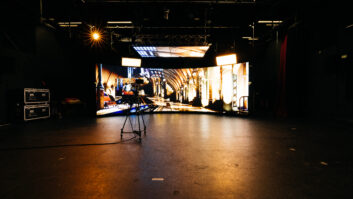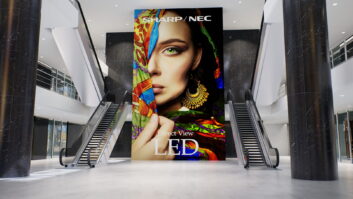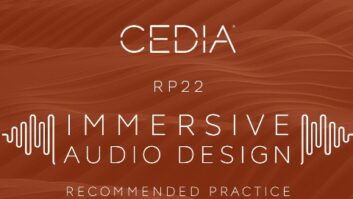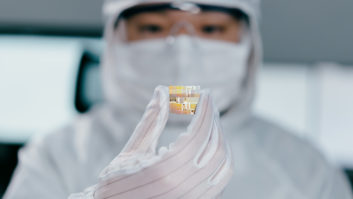The scope of education has broadened considerably since the days of the ‘Three Rs’ (Reading, wRiting and aRithmetic). While those basics and subjects such as history, biology and English literature remain at the core of school curricula, there are many areas of working life that young people are now aspiring to which were not generally catered for in schools and colleges 40 to 50 years ago.
Alongside computer and game programming, two notable examples of this are broadcast production and music recording. While radio and TV journalism courses began to be offered in the 1980s and the concept of the Tonmeister dates back to the 1940s – with now many such training institutions in mainland Europe and, notably, the University of Surrey in the UK – it is only in the last 20-30 years or so that a proliferation of schools, colleges and universities have added these subjects to their curriculum.
This has necessitated the building of technical facilities that give students the opportunity to familiarise themselves with the kind of equipment used in professional environments. “Specialised broadcast and recording equipment in schools aims to mirror real-world standards, providing students with hands-on experience using professional-grade tools,” confirms Sam Dimond, director of Spotlight Sound, a UK event production and AV installation company with a particular focus on education.
A recent project for Spotlight was at the Thriftwood School in Essex and although the aim was to provide sound reinforcement for assemblies and performances rather than a specific training facility, the Yamaha-based system is of a professional standard. Dimond comments that while specific requirements vary depending on the age of the pupils/students and the level of the course, essential components will typically include quality microphones, audio interfaces, cameras and editing software.
BROADCASTING CAPABILITY
As well as specific training facilities, usually aimed at post-graduate students looking to work in the media, many established colleges and universities now have similar courses on the prospectus. Less common is for secondary-level schools in Europe and – particularly the UK – to have broadcasting capability in particular.
“The UK does lag behind the US in that sense,” says Marc Risby, managing director and chief technology officer of equipment distributor DigiBox. “We work with NewTek, which is now branded as Vizrt, and they can give a dozen examples of US high schools running a TV channel to record and stream all their sports games. And the TV station is part of the curriculum. It is providing a service – streaming the sports or graduation ceremonies – but the students are also being taught how to use the video and sound equipment. In the UK that doesn’t fit the National Curriculum and apart from some independent schools, we don’t have the volume [of facilities] that I think we should have.”
In the UK, this kind of vocational, hand-on experience is available from higher education or specialised institutions, such as the south London-based music charity World Heart Beat. It has been offering music education to disadvantaged young people since 2009 and recently expanded with the opening of new premises on the South Bank of the River Thames. World Heart Beat Embassy Gardens features a music auditorium, recording studio and broadcast suites alongside teaching areas.
Among the technology brands available to students are Vizrt, Solid State Logic, Focusrite and d&b audiotechnik, which all donated equipment. Part of the brief from World Heart Beat chief executive James Gero was for “a significant increase in our streaming capabilities”.
This has been achieved in part using (NewTek) TriCaster Mini systems from Vizrt, which are being used for remote learning, relaying master classes and recitals through the building and transmission of live performances to global audiences.
Vizrt product manager Liam Hayter describes the TriCaster Mini as an “entry-level system” that enables educational and training facilities such as World Heart Beat to have the same kinds of capabilities as higher-end systems. “Any educational institution today looking to provide broadcast and music recording pathways should be planning around a network-based and software defined approach,” he says. “This is important because traditional baseband infrastructure based on SDI, HDMI and analogue audio systems will largely be phased out by the time students enter the industry, regardless of higher education or not.”
NARROWING GAPS
Hayter also notes that the gap between professional broadcast operations and those provided in the education sector is narrowing due to the influence of lower cost computer and IP technologies. “The emergence and adoption of computers, software and networks as the way to produce and create live content has led to a rapid democratisation of broadcast technologies,” he says.
“High-end broadcast budgets are shrinking, which has led to a ‘doing more with less’ approach. ‘Broadcast’ technology is also becoming available to all. Just look at journalists, who are increasingly using mobile phones and PTZ cameras for their reports, which students can do too.”
The Fontys School of Journalism in the south Netherlands city of Tilburg recently opened a new TV studio to be more in tune with current technology. “Our previous studio, which had been in operation for over a decade, was built for a different use case and although it had served us well it had reached the end of its useful life,” says Sjoerd van den Bersselaar, the school’s AV hardware technician. “Flexibility and adaptability are paramount in a rapidly evolving world of media production. A cutting edge studio that we can quickly reconfigure to accommodate diverse needs is a valuable asset.”
The studio was designed and built by Fontys Journalism to meet these criteria. It is located in the MindLab innovation centre, which opened earlier this year and is owned by the municipality of Tilburg and Fontys University of Applied Sciences, of which the School of Journalism is a part. The facility is based on Blackmagic Design systems, including an ATEM Constellation 8K live production switcher, a 40×40 12G Smart Videohub, four URSA Broadcast G2 cameras with Fujinon ENG lenses, an ATEM Camera Control panel and a SmartScope Duo 4K waveform monitor.
Rather than have AV technicians run all the equipment, Fontys’ aim with the new studio is to make the students a big part of the production operations. “In traditional settings, they might have remained on the side-lines,” says van den Bersselaar. “However, we understood the importance of providing tomorrow’s journalists with practical experience allowing them to understand the entire production chain.”
EDUCATION EXPERIENCE
Hands-on experience is the basis of the Education Roadshows organised by distributor and technology supplier CVP. These give students the opportunity to gain first hand practical experience in handling equipment, with supervision from experienced technicians and established broadcast and film professionals. Business development director Steven Baxter agrees that the requirements for broadcast and music recording facilities “vary depending on the level of education and the specific courses being offered”.
Among the general requirements for facilities, Baxter outlines: spaces that can “perform acoustically” or have the potential to be modified to do so; sound and vibration proofing; flexibility in the space to accommodate a variety of activities –interviews, panel discussions, gallery-based broadcasts, stage-based performances – and media types, such as broadcasting and social media; adequate lighting rigs to provide proper illumination for different productions; additional equipment including cameras and audio recorders and mixers; and adequate storage for everything.
Baxter adds that film schools and music conservatories will typically have more sophisticated facilities than general schools and colleges because they have to allow their students to gain the skills and experience for working in professional situations. “However, technological advances have made it possible for schools and colleges to have facilities that offer comparable performance to those of specialised institutions,” he says.
ACCELERATING CHANGE
The rate of technological change today only appears to be accelerating, which means that during a three year media course, for example, what is being used in ‘the real world’ could be different to what students have been learning.
“The rapid technological advancements in the industry necessitate that educational institutions invest in regular and frequent updates to their facilities,” agrees Daniel Sosnowski, head of technical and teaching resources at the Faculty of Arts and Creative Industries of Middlesex University. “This ensures that the resources remain current and in line with what students will encounter in professional settings.”
Middlesex University’s facilities include a recording studio with an Avid HDX2 system running Pro Tools HD 12, two radio studios and two TV studios with three control rooms. Among the equipment used by film and TV students include Canon EOS and Cinema cameras, such as the EOS R3, R5 and R6 Mk II.
“Beyond providing cutting-edge technology, practical experience is a cornerstone of our approach, aimed at helping students not only master the tools but also understand the nuances of working in a professional broadcast or recording environment,” Sosnowski comments.
Right now, virtual production and extended reality (XR) are the technologies being weighed up by colleges and universities – just as they are by broadcasters and production companies. Among the most recent installations of a LED volume for education is at the University of the Arts London (UAL), which announced at IBC 2023 it was the first customer for Sony’s new Crystal LED VERONA displays. These will be used to develop a specialist PhD virtual production research volume, due to open early next year under the auspices of UAL’s Fashion Textiles and Technology Institute (FTTI).
ARTS FOCUSED
Marcus Saunders, associate director of technical resources at UAL, acknowledges that the FTTI’s use of the volume will be far more specialised and high-end than what other educational institutions might be considering, with the cameras being evaluated including cinematography models such as Sony VENICE and ARRI Alexa Mini LF or Alexa 35. “The focus is not vocational but more arts-oriented,” he explains. “But we also have plenty of DSLR cameras and systems that are used for the journalism courses as part of the UAL’s College of Communication.”
A technology that Saunders sees as becoming increasingly part of broadcast set-ups, both for students and fully-fledged professionals, is the NDI (network device interface) protocol. Tony Gill, managing director of Avid reseller Altered Images, agrees, saying it has “changed the game”. Altered Images has supplied Avid iNEWS newsroom systems and Media Composer visual effects workstation to education institutions that are looking to give students a grounding in what is being used by broadcasters and news organisations.
SOCIAL SKILLS
Gill observes that beyond vocational and practical training, new technology like NDI can also help in giving students ‘soft’ or social skills, which are crucial for getting on in the workplace. “We provided systems for the media courses at the University of Wolverhampton and all the different disciplines – journalism, games design, stop motion animation and the green screen and virtual facilities – are tied together with NDI,” he explains. “That helps make the students collaborate with each other and gives them a better idea of working with people.”
In what is likely to be an increasingly crowded employment market, giving students as much knowledge of their subject, practical experience and confidence is as important as the technology they will be using.
Whilst virtual production isn’t particularly taking off in corporate at present, he said that there is a huge amount of investment going on in colleges & universities – both for general teaching purposes and to support film & media production courses. (This also ties in with the fact that a number of universities are preparing to introduce virtual production qualifications.)







